 |
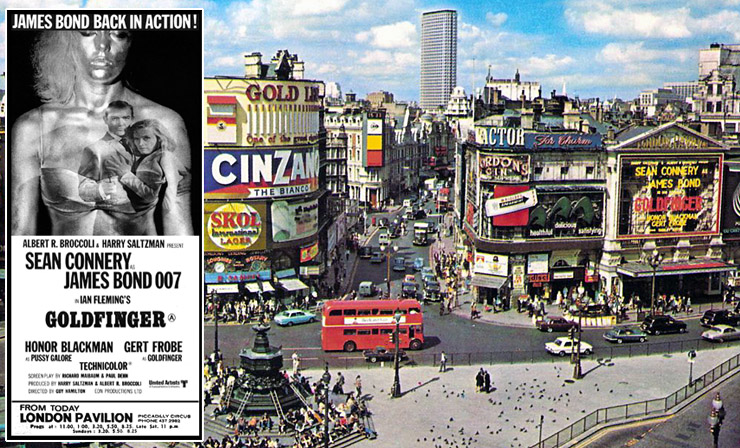 |
|
“A Bond-Buster of
a Programme!”
With Goldfinger
not seen on UK cinema screens for just over two years, it became the
perfect choice to be paired with Thunderball - the most successful James Bond film to
date, in what would be the second official 007
double-bill released by United Artists. Goldfinger was originally revived at the London Pavilion,
Piccadilly Circus for two weeks commencing Thursday June 20, 1968, (just
five weeks after
Operation Kid Brother starring
Sean Connery's brother Neil had vacated the venue). This was followed
on July 4, 1968, by Thunderball which played for another 13
days, finishing on July 16th to make way for the World Premiere of The
Beatles Yellow Submarine. Along with Thunderball, the
double-bill of Dr. No/From Russia With Love had proved to be one of
the biggest money-spinners for distributor United Artists in 1965/66. In July 1968 Goldfinger/Thunderball
was re-issued as a double-bill to play in the
evenings as part of a new programme with Thunderbird 6 showing
in the
afternoon.
The National Screen Service once again produced an Exhibitors’
Campaign Book and poster for this re-release. Although not
technically a triple-bill (Thunderbird 6 was designed to play
afternoon matinees for children as a ‘U’ certificate; and the two Bond films for
adults as ‘A’ certificates in the evenings), a full-colour quad-crown
poster was produced and used in those cinemas that played all
three films. Many cinemas chose to simply book Thunderbird 6;
whilst others across the country opted for the 007 double-bill. A
separate quad-crown poster was available for the two Bonds, but due to
its uninspired design was rarely used. Most cinema
managers simply created their own foyer display using two single
double-crown posters (20" X 30") also available from the National Screen Service.
Thunderbird 6 and Goldfinger/Thunderball played at
cinemas on the Rank circuit in London and across the country during
July and August 1968 (although opened first in Scotland on Monday July
15, 1968). |
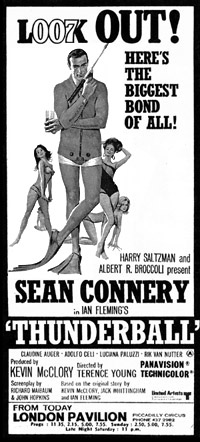 |
|
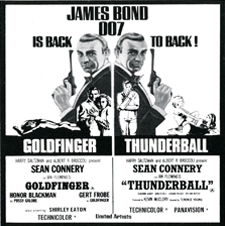 |
The new James Bond
double-bill of Goldfinger/Thunderball only played in
London's West
End for one week at the New Victoria from Thursday July 18, 1968, and
concurrently at the ODEON Kensington. As the school holidays did not
start in London until the following week neither cinema showed
Thunderbird 6, although the film had unusually already has its
World Premiere engagement at the 300-seat Jaceyland cinema within
Baker Street Underground station on Thursday June 26, 1968, where it
played for five weeks before a wider release with the two James Bond
films. |
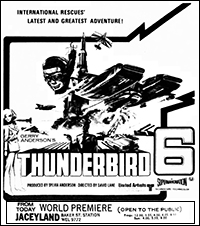 |
|
|
Although completed in
late 1967, United Artists were unsure when to release the second
Supermarionation film given the relatively poor box-office performance of
its predecessor Thunderbirds Are Go, which had premiered at the
London Pavilion on December 12, 1966. With United Artists’ flagship venue
playing the two James Bond revivals in June/July 1968 this was presumably
why UA selected the small Jaceyland cinema as the venue for the premiere
engagement of Thunderbird 6 in London. The cinema (the only one
situated within a London Underground station) had originally opened in
1938 showing newsreels, and was a popular venue for the screening of
children's films, cartoons, and later cult classics. |
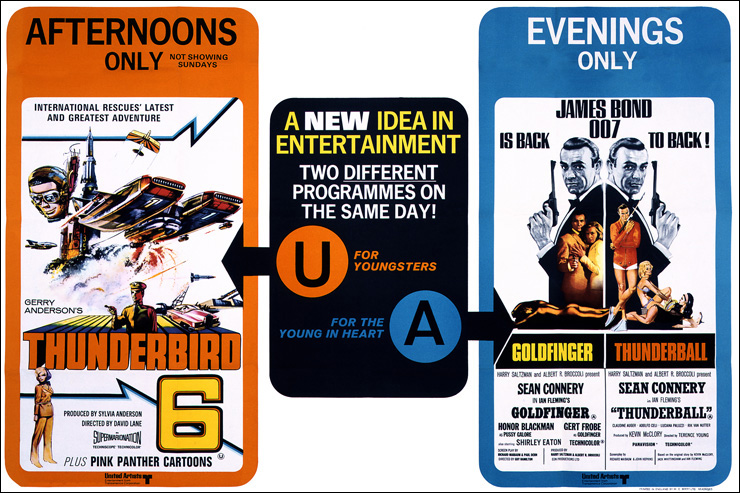 |
|
ABOVE: UK quad-crown poster [30"
X 40"] for those cinemas
that screened Thunderbird 6 and Goldfinger/Thunderball.
BELOW: (left) What's On IN LONDON magazine promoting the
‘New Idea In Entertainment’ which played in North London from
Sunday July 28, 1968, and South London cinemas from August 4, 1968.
The three films had first opened in larger cities north of the
border from Monday July 15, 1968 as the Scottish summer school
holiday traditionally started a week earlier than in England. The
trio of films also played across the UK in late July/August 1968.
(right) The ODEON Oxford Road in Manchester screened the three
films from July 28th, but they did not reach provincial Manchester
cinemas until the end of September. |
|
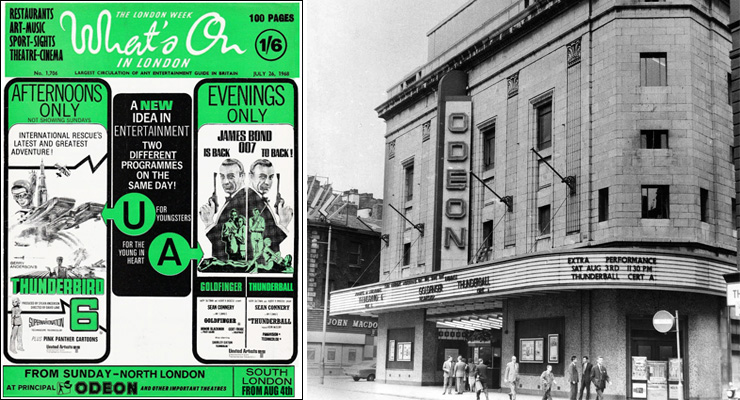 |
|
|
United Artists’ concept of
‘A New Idea In Entertainment’ was a very short-lived experiment and lasted
only six weeks (the length of the UK school summer holidays) in 1968. The
idea of two different programmes on the same day was not repeated,
although a few provincial cinemas did revive the programme just after
Christmas 1968, where once again they had a captive audience. This was
generally in those cities that had not originally booked Thunderbird 6
in the summer, and could therefore advertise it as a premiere
engagement. |
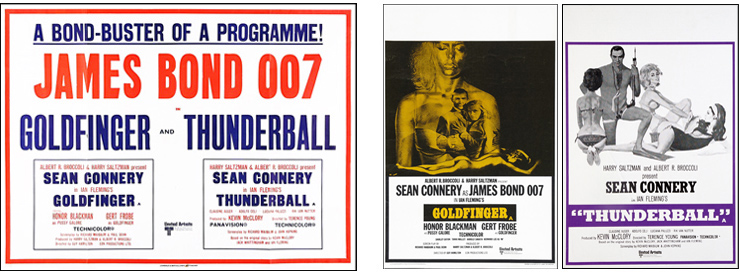 |
|
ABOVE: (left) The extremely rare
UK quad-crown poster available for those provincial cinemas which chose to play
the Goldfinger/Thunderball double-bill. (right)
Goldfinger and Thunderball double-crown posters [20"
X
30"] were available to cinema managers wanting to create their own foyer
displays. |
|
|
|
“Double the
danger!”
You Only Live Twice was released again on a double-bill with
Dr. No at the London Pavilion for two-weeks from Thursday February
27, 1969. An alternate double-bill
of You Only Live Twice/From Russia With Love also played
concurrently at the
1,934-seat New Victoria cinema (Now the Apollo Victoria) for one-week. Both
double-bills had new quad-crown posters
available from the National Screen Service, and went on general
release across the UK from Sunday March 23, 1969. Since Sean Connery's
announcement that You Only Live Twice would be his last James
Bond film, no official advertising for the double-bills connected his
name with the character, and these posters simply stated
‘Starring Sean Connery’. It was not until his return in Diamonds
Are Forever was announced in 1971, that posters once more linked
him to the character of James Bond.
|
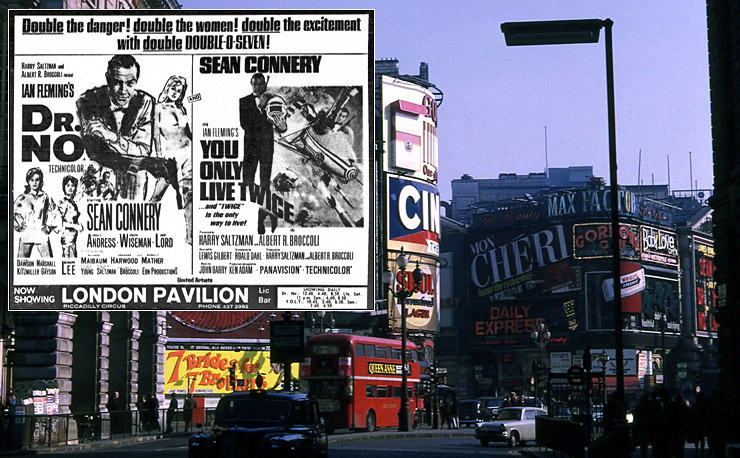 |
|
ABOVE: Dr. No/You
Only Live Twice played at the London Pavilion for two
weeks from Thursday February 27, 1969.
BELOW: An alternate double-bill of You Only Live Twice/From
Russia With Love played at the New Victoria for one week
commencing Thursday February 27, 1969. Both double-bills then
went on general release across the UK from Sunday March 23,
1969, accompanied by alternate quad-crown posters. Note that
the advertisement block pictured below utilises line drawings
of the From Russia With Love poster artwork not seen on
any other publicity for the film. Although
Renato Fratini's
original
illustration of Sean Connery was later used
on the cover of the
booklet for the January
1980 James Bond Season screened at the National Film
Theatre on London's South Bank. The original advertising campaign
for From Russia With Love (1963) utilised a revised
version of Fratini's artwork. |
|
 |
|
|
|
|
The two double-bills
were offered as a ‘Split Release’, but instead of a choice from two
different films screened on the Rank distribution circuit in any one
week, cinemas had the option to
show You Only Live Twice with either
Dr. No or From Russia With Love. Two different
quad-crown posters were available from the National Screen Service
depending on the programme booked. Following the general
release of the two double-bills across the UK, Sean Connery's five
James Bond films were then withdrawn from circulation at the end of
1969. |
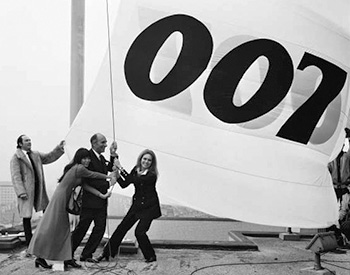 |
|
On Monday December 1,
1969, three weeks ahead of the premiere of On Her Majesty's
Secret Service, Swiss Ambassador René Keller hoisted a huge
007 banner over the Swiss Centre in London, which was taken over
and turned into a James Bond headquarters to showcase the country
which featured so prominently in the new film. The
press launch [pictured above left] was attended by Director Peter Hunt and two of Blofeld's ‘Angels of Death’: Mona Chong (Chinese Girl) and Joanna
Lumley (English Girl). The Swiss Centre was a
popular tourist attraction on the edge of Coventry Street at its
junction with Leicester Square. Opened in 1968, the 14-storey
building was both a showcase for Switzerland and its products; and
a trade and commercial centre featuring a Swiss bank, tourist
office, a chocolate and souvenir shop, a Swissair ticket
office, with a cafe and several Swiss themed restaurants located
in the basement.
|
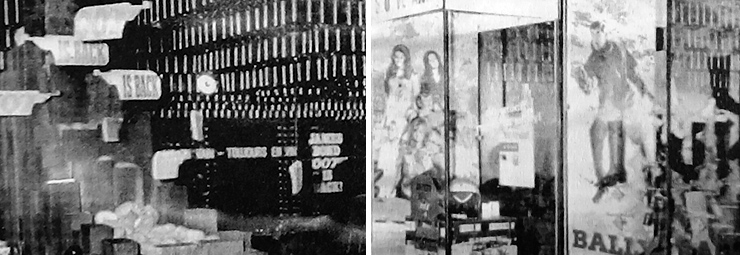 |
|
For the OHMSS
promotion the stores and restaurants [pictured above] all had James Bond themed
displays. In 1973 the small
Scene 1-2-3-4 cinema opened on the third floor of the Swiss
Centre. Over the years the connection with Switzerland faded and
several shops remained vacant until British souvenir stalls took over
the commercial spaces from the late nineties. The building was
demolished in 2008. |
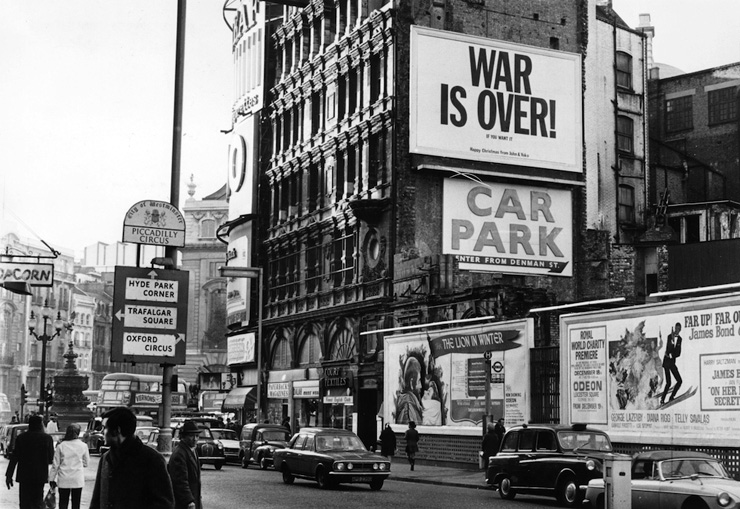 |
|
ABOVE: Shaftesbury
Avenue
1969. Advertising hoardings announce the forthcoming
release of On Her Majesty's Secret Service at the ODEON Leicester Square; and The Lion In Winter (1968) which was
currently showing at the ODEON Haymarket. Both films
featured a soundtrack by John Barry who would win a second Academy
Award for his outstanding score for The Lion In Winter; the
film also marked the screen debut of a 22 year-old Timothy Dalton
playing opposite Katharine Hepburn and Peter O'Toole. The Lion
In Winter played for an unbroken 79-weeks at the ODEON
Haymarket from December 1968 - July 1970! |
|
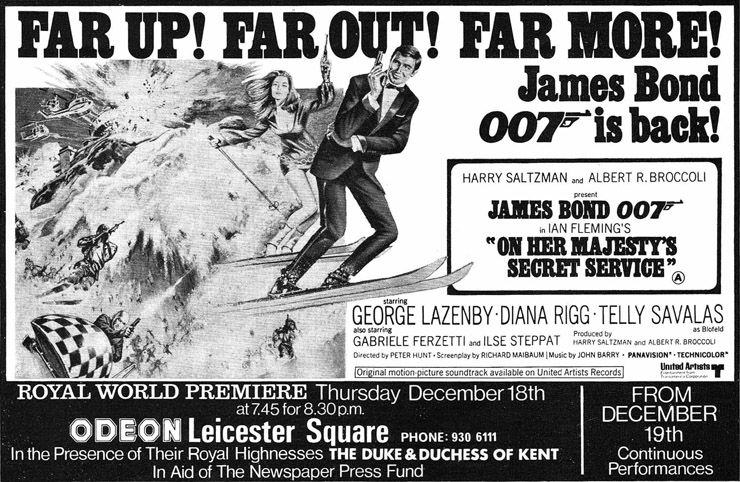 |
|
|
“Far Up! Far Out!
Far More!”
On Her Majesty’s Secret
Service had its Royal World Charity Premiere at the ODEON Leicester
Square on Thursday December 18, 1969, with new James Bond George Lazenby attending alongside co-star
Diana Rigg. Also attending were Producers Harry Saltzman & Albert R.
Broccoli, Director Peter Hunt, and Composer John Barry. Broccoli &
Saltzman invited their former producing partners including Irving
Allen (1905-1987) [who had formed Warwick Pictures with Broccoli], Benjamin Fisz
(1922-1989) [who had produced Battle of Britain (1969) with Saltzman] and Thunderball
Producer Kevin McClory. The premiere's after party was held in the
Napoleon Room at the
Café Royal on Regent Street, where among the invited guests were Ian
Fleming's widow Ann (1913-1981) and son Caspar (1952-1975). The On
Her Majesty's Secret Service premiere raised £23,000 for The
Newspaper Press Fund. |
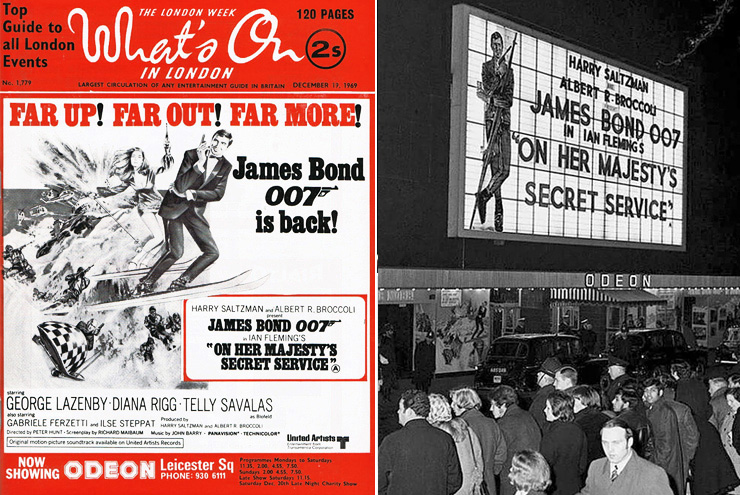 |
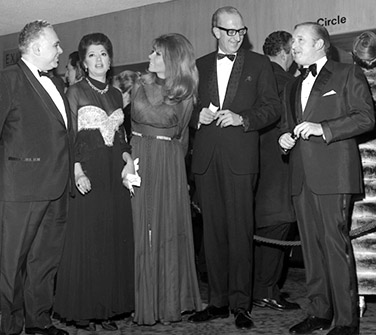 |
|
ABOVE: (L-R)
Co-Producer Harry Saltzman and his wife Jacqueline; actress
Ingrid Pitt with her husband George Pinches, and Eric Pleskow
(United Artists Vice-President of international distribution)
at the premiere of On Her Majesty's Secret Service. |
|
|
On Her Majesty's Secret Service
then had a trade show at the London Pavilion on Friday December 19th
at 10.30am, with the first public screening at the ODEON Leicester
Square at 11.35am on the same day. The ODEON also hosted another
late-night charity show on December 20, 1969.
There was initially some concern over the length of the final cut of On Her Majesty's Secret Service, which at 142-minutes
would restrict most cinemas to three screenings each day. Director Peter Hunt
had invited George Pinches (booking manager of the Rank Organisation who
distributed the film on the ODEON circuit in the UK), to a screening at EON
Productions offices in Audley Square prior to release. Pinches loved the
film and felt it wasn't too long so advised against cutting it down further. Peter Hunt
also suggested that extra late night screenings could provide additional
revenue as they had for Goldfinger (1964) and Thunderball
(1965), but this
idea does not appear to have been followed through outside London's West End,
apart from a few special midnight matinees when OHMSS opened in major
cities as part of its general release in March 1970. |
|
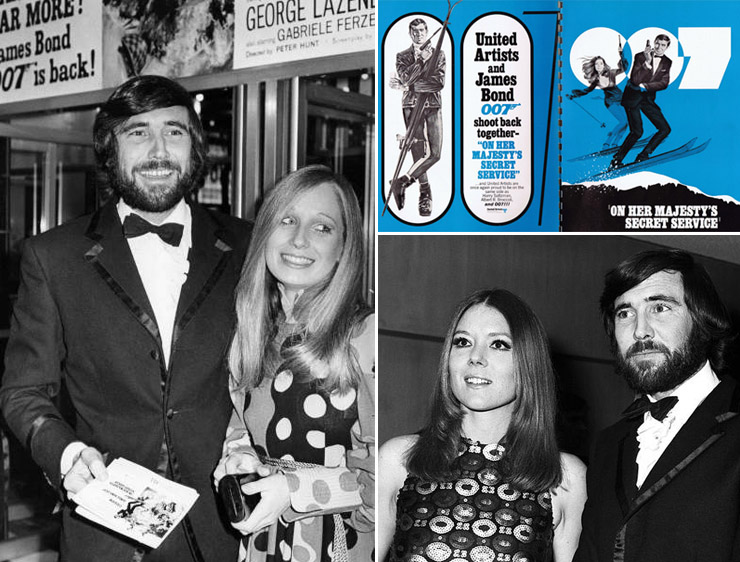 |
|
ABOVE: (left) George Lazenby arrives at the ODEON Leicester
Square accompanied by actress Polly Williams (1950-2004). Lazenby had
announced his resignation from the role of James Bond on November
23, 1969, and the producers then refused to pay him to do any
publicity for the film. In early December the actor undertook his
own self-funded press tour to promote the film in the USA and
arrived back in England on 18th December with long hair and sporting a full beard,
which he refused to shave off for the premiere. (top right) The
spiral-bound On Her Majesty's Secret Service Premiere
brochure bore no mention of Lazenby's name on the cover. (bottom
right) George Lazenby and co-star Diana Rigg at the On Her
Majesty's Secret Service Premiere at the ODEON Leicester
Square on the evening of Thursday December 18, 1969.
BELOW: (left) Thunderball producer Kevin McClory with On
Her Majesty's Secret Service Co-Producer Harry Saltzman
(right) Composer John Barry is presented to HRH The Duchess of
Kent (1933-2025) at the Premiere of On Her Majesty' Secret Service. To
the left of John Barry are OHMSS Associate Producer Stanley Sopel and
Director Peter
Hunt. |
|
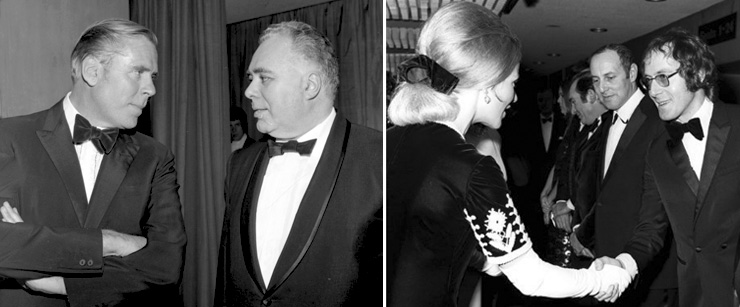 |
|
|
On Her Majesty's
Secret Service broke the all-time house record at the ODEON Leicester
Square set by You Only Live Twice, taking £22,883 in its second week of release - a fact United Artists were only too happy to
celebrate.
George Lazenby’s only Bond
outing was also hugely popular across the UK and was still on release
provincially nine months after its initial opening. The lack of new
films meant that some cities such as Manchester were playing On Her
Majesty’s Secret Service at three cinemas simultaneously in
September 1970. This no doubt contributed to its overall success at
the box-office during the initial release. United Artists later succeeded in
luring Sean Connery back for Diamonds Are Forever, and in a 1971
interview for the BBC he famously commented on the lack of success of its
predecessor. The US release of On Her Majesty’s Secret Service
was initially hampered by the New York Times listing it as one of the
10 worst films of 1969, although many other US newspapers gave the
film more positive reviews.
A disastrous US TV showing in 1976
(re-edited and screened over two nights) didn’t help matters. The myth
that OHMSS was a box-office disaster
perpetuated for many years resulting in it becoming the black sheep of
the franchise, only being finally restored to the position it now
holds through the emergence of Bond fandom in the early 1980s, and its
continued championing in 007 MAGAZINE. |
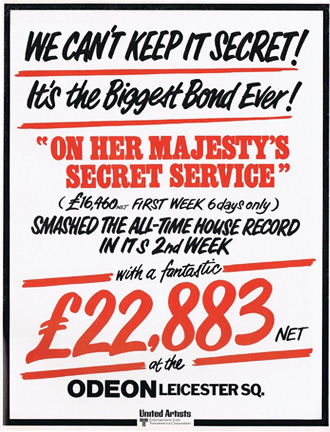 |
|
|
After six weeks at the
ODEON Leicester Square, On Her
Majesty’s Secret Service then transferred to the London Pavilion
on Thursday January 29, 1970, where it played for a further seven weeks
until Wednesday March 18, 1970. On the March 7, 1970 edition of the trade
magazine Kine Weekly it was reported that On Her
Majesty's Secret Service had not exhausted its box-office potential at
the Pavilion, where it took a respectable £4,920 in its fifth week. On Her
Majesty's Secret Service also played concurrently for three weeks at the New Victoria
from Thursday January 2, 1970. Like its predecessor, On Her Majesty's
Secret Service was also chosen as a special ‘Pre-Release Presentation’
at selected cinemas in Greater London before going on general release
across the country on March 1, 1970. OHMSS was booked in for a
two-week engagement at these theatres from Sunday February 1, 1970, with
the exception of the Granada Harrow where it played for three weeks.
Saturday late night shows were also approved at many locations. |
 |
|
On Her Majesty's
Secret Service then transferred to the Cinecenta in Panton Street (just off Leicester Square
and Haymarket), for three weeks commencing Thursday March
19, 1970. For the first week it played on the 138-seat Screen 1,
then moving to the 145-seat Screen 4 from Thursday March 26, 1970. Opened in
January 1969, the Cinecenta was Europe's first four-in-one cinema. After
several take-overs and name changes the cinema is now called the ODEON Luxe Haymarket.
On Her Majesty's Secret Service also played concurrently at the
small 187-seat Cameo-Poly cinema on Regent Street (part of the Classic
chain) for three weeks from Thursday March 19, 1970. |
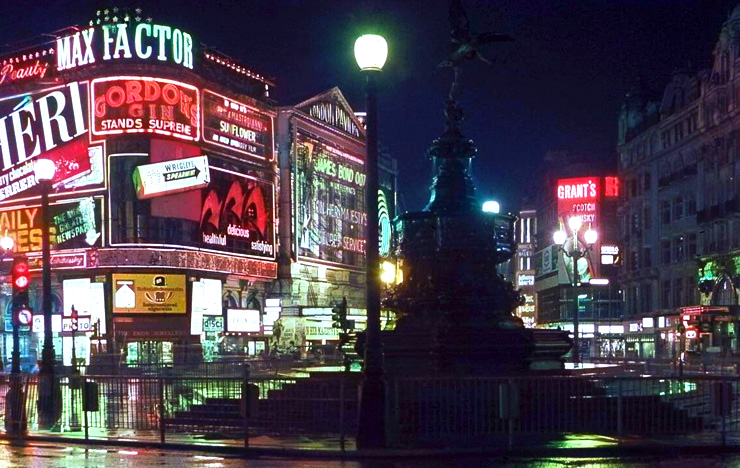 |
|
ABOVE:
Piccadilly Circus 1970. On Her Majesty's Secret Service
transferred to the London Pavilion, Piccadilly Circus following its initial
six-week engagement
at the ODEON Leicester Square. |
|
|
|
|
On Her Majesty's Secret
Service then had
regional midnight premieres in several UK cities on Saturday February 28,
1970 - the day before its general release across the country. Although On Her
Majesty's Secret Service continued to be shown across the UK
throughout 1970 and early 1971, it would be another nine-months before it was seen again
in London's West End. George Lazenby's only
outing as 007 then played for seven days at the 489-seat Classic cinema on Baker
Street from Sunday January 10, 1971. The Kensington Post newspaper
commented at the time that this was a rare opportunity to see the film
with Bond Mark II, who wasn't as bad as the critics made him out to be.
The 400-seat Classic cinema on Praed Street then screened On Her
Majesty's Secret Service for seven days from Thursday April 1, 1971,
after which the film became increasingly hard to see until its 1974
re-release with Live And Let Die. |
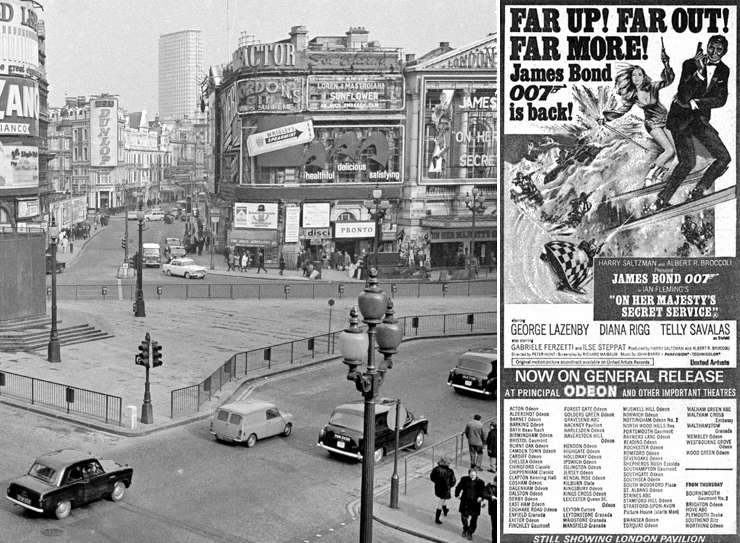 |
|
None of Sean Connery's James Bond films were screened in the UK whilst
On Her Majesty's Secret Service was on release.
Unlike Casino Royale
(1967), which was more popular in London than in the suburbs, On
Her Majesty's Secret Service proved more successful in the provinces,
with many cinemas holding the film over for
several weeks. On Her
Majesty's Secret Service was later re-issued twice more on
double-bills with Live And Let Die in 1974, and Diamonds Are
Forever in 1976 (and provincially in 1978). Although George Lazenby had announced that he would
not be playing 007 again, On Her Majesty’s Secret Service
went on to become the highest-grossing film of 1970 in the UK. Cinema
attendance across the world was by then at an all-time low, and many box-office
failures in genres that were normally hugely successful, had changed
the way films were made and marketed in the next decade. |
|
 |
 |
|







